A common scenario for Exchange Server administrators is a customer that needs to change their primary email addresses to a new domain name.
For example a company that uses @exchangeserverpro.net as their email address might be acquired, or merge, or simply be rebranding to another name and wants to use @exchangeserverpro.com as their email address instead.
The Exchange Server administrator’s task is to:
- Make the new primary email addresses of @exchangeserverpro.com begin to work
- Make the previous email addresses of @exchangeserverpro.net continue to work
There are two features of Exchange Server 2007/2010 that need to be changed for this to happen.
Accepted Domains
The first feature is the Accepted Domains. This is the feature that tells an Exchange 2007/2010 organization which domain names it will accept mail for, and how to treat that domain name.
Accepted domains can be authoritative (ie, the organization owns the domain name and uses it for mail recipients) or can be a relay domain (ie, the organization will accept the emails but send them elsewhere).
There are a few other options such as shared SMTP namespaces but for the purposes of this scenario we’re just dealing with authoritative domains.
To add a new domain name to the organization launch the Exchange Management Console and navigate to Organization Configuration/Hub Transport. Select the Accepted Domains tab to view the current list of domains.

In the Actions pane click on New Accepted Domain.

Enter a Name and the Accepted Domain itself. The name can really be anything you like but most administrators just make it the same as the domain they are adding.

Click New and then Finish to complete the wizard.
Note that if you have Edge Transport servers deployed in your network they will not receive the updated list of Accepted Domains until the next scheduled synchronization of the Edge Subscription.
Email Address Policies
Now that the new domain as been added as an Accepted Domain the next step is to configure an Email Address Policy.
Email Address Policies determine which SMTP addresses as are assigned to which objects in the organization, such as mailboxes, contacts, and distribution groups. Each organization has at least one Email Address Policy that by default will apply to all mail-enabled objects.
Here we can see mailbox users assigned with @exchangeserverpro.net email addresses.
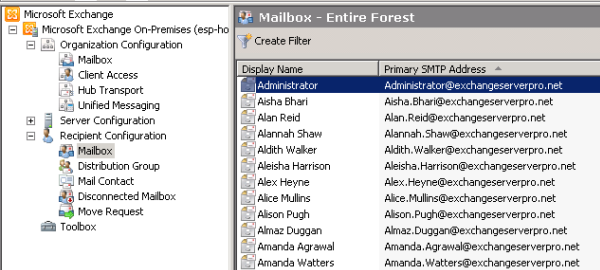
In the Exchange Management Console navigate to Organization Configuration/Hub Transport, and then select the Email Address Policies tab.
In this scenario we’ll just modify the default policy for all mail-enabled objects. Right-click the Default Email Address Policy and select Edit.
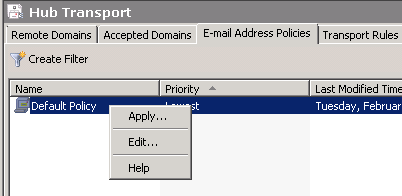 Click Next to skip past the introduction and conditions, until you reach the Email Addresses part of the policy. Click on the Add button.
Click Next to skip past the introduction and conditions, until you reach the Email Addresses part of the policy. Click on the Add button.
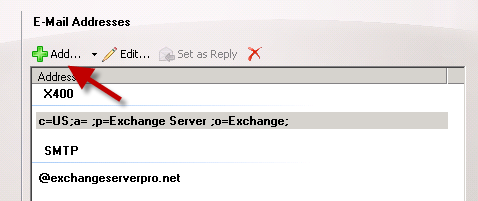
The Email address local part is an optional setting. If you do not specify one the Alias is used as the prefix of the email address. If you do specify one you can use the Alias or other combinations such as Firstname.Lastname.
Next type the domain name or click Browse to choose it from the list of Accepted Domains.
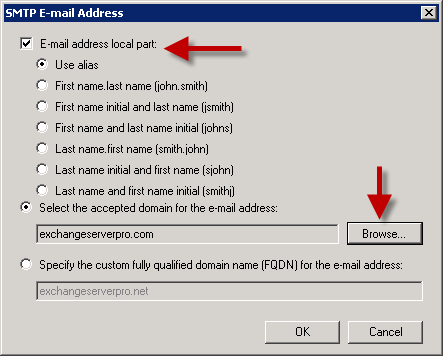
Click OK once you have configured the new SMTP email address. Select the newly added SMTP address and click on Set as Reply.
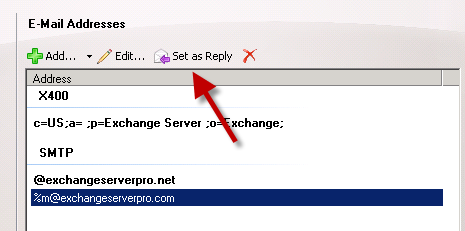
This will change the new address to bold, which means that it is the address that mail will appear to be sent from. The other email addresses in the policy will allow people to continue to receive email sent to those addresses.
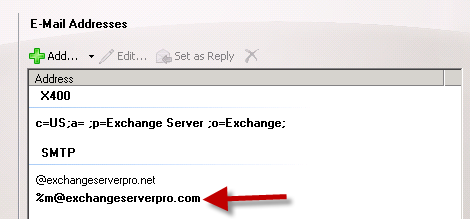
Click Next to continue. Now we can choose when the updated policy will be applied to recipients. Usually this will be immediately, however you can choose not make the changes without applying the policy, or schedule it for a later time.
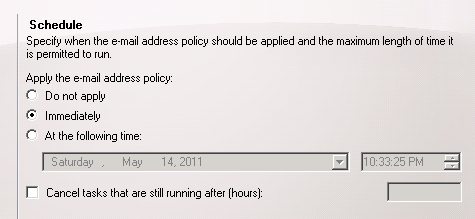
Click Next, and then click Edit to complete the wizard. Depending on the size of your environment this may take some time to finish applying.
After the new policy has been applied you can see the change by refreshing the list of mailboxes. Notice that the primary SMTP addresses have changed from @exchangeserverpro.net to @exchangeserverpro.com.
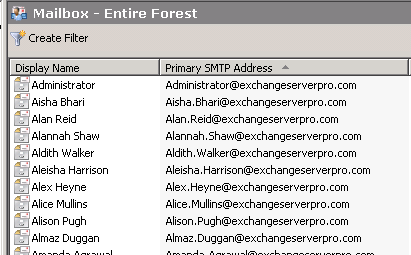
If you look at one recipient you can see that the new primary SMTP address has been applied by the policy, and the previous email address has been retained as well to allow mail sent to that address to continue to be received.

You can see that after these tasks have been completed the organization has had the primary email domain changed to a new one while preserving the existing one at the same time.




Thanks , its help me still.
sorry, i want to ask out of the topic. i had microsoft exchange 2010, but i can’t send email to a domain, for the example the domain is *@gmail.com. where are the possible problem? but for the other domain there are no obstacles.
thank you
ASA
Hi Paul,
Thanks for sharing a lot of material and notes on EX 2016. I have a lab setup at home running EX2016CU10. So far everything is working fine with Public Cert.
Just want to find out, if it is possible to configure multi domain within single Exchange 2016. Here is my lab setup.
DC with AD on ramlan.ca
Exchange Cert – mail.ramlan.ca
Exchange 2016 fully configured
GoDaddy MX and A record done
Remote Connectivity Analyzer checked – all GREEN
I want to include another authoritative domain into exchange which will be called infotechram.com. I have this domain at GoDaddy.
What configuration, I need to perform on the exchange side to send and receive email for both the domains (ramlan.ca + infotechram.com) ?
So far, I have completed the following:
1. Created new authoritative domain in Ex 2016 (infotechram.com)
2. Edited email address policies and added new authoritative domain under email address format
Appreciate your help on the above.
Hi,
you talk about @practical365.com domain but in the pictures you are changing @exchangeserverpro.net to @exchangeserverpro.com?
I can follow you but this is confusing a bit.
Hi Paul,
Currently we have an exchange server 2007 and using 123.com and wanted to change to abc.com on your guide above do we need to add new MX record and DNS record for abc.com? after that what will be the next step?
Yes, you will still need to set up MX records for the new domain.
Hi Paul,
It is necessary to add the MX and CNAME record in the Public/Internal DNS?
Thanks, best regards.
MX records are necessary for other servers on the internet to be able to send you email to your domain, so they need to be added to public DNS.
I’m not sure which CNAME record you’re referring to, but generally speaking you need to add DNS records to public DNS zones if you expect other hosts on the internet to be able to resolve that CNAME.
Hi Paul,
Could I pick your brain on this problem please?
We’ve recently moved from Exchange 2003 (domain “A”) to 2010 (domain “B”) with new servers too.
When outlook 2010 opens for some of our users, it states “the server is unavailable” and if I click ‘work offline’ the wrong server is shown in the ‘general’ tab of the box that opens. It says “ExchangeSVR.a.internal” instead of NewExch.b.internal. For other users, it seems to work fine.
My question is, how does the Outlook client know which server to go to when creating a profile for the first time? I’m guessing I need to make a change somewhere to remove the old server & domain entry, but would this be on the Exchange Management Console/Powershell or is it set when Outlook gets installed?
Our users are still on Domain “a”.
Our PCs and the new exchange server is on Domain “b”.
ExchangeSVR no longer even exists.
Should there be an entry in DNS on either domains for autodiscover, as I cannot find anything.
If you need any further information, please let me know.
Thanks in advance!
Outlook uses Autodiscover to locate the server configuration options it needs to connect with. In your situation you’ll need to look into cross-forest Autodiscover.
Hi Paul,
I am facing some issue regarding Email Address policy, we have changed our smtp domain address earliar it was @tpc.com and now its changed to @cpl.com the problem is that we have added email address policy and that is replacting to upto 800 mailbox only after that its stoping not changing for rest of mailbox out of 3000,, and second one is how to apply changes for those mailbox whose having “unchecked box for automatically update email address” for some mailbox we have added manually smtp address other than standard address for other as “first name last name” but for these mailbox we have created there emails with different common name. so for these mailbox we are unable to apply the New Email address policy please suggest how to do that we are in middile in this activity.
Hi, I am facing one problem, here we have several accepted domains.
consider we have 123.com, abc.com, xyz.com etc, and have many mailboxes.
some are having 123.com as primary SMTP some are having abc.com as primary SMTP and some are having xyz.com as primary SMTP.
Now am in a situation that ONLY users having 123.com as primary SMTP need to be changed to abc.com as primary SMTP, no changes should happen to xyz.com, is there any way I can change it without going to every mailbox and change it manually, No idea how I will do it. It will take days to change all manually.
Do I need to change the CAS URLs? like Auto discover URL?
Is the Outlook client going to use new domain or old one?
I have a question, which is related to changing the primary email domain however more to do with the Internal/External URL’s.
We are already utilising the new domain name as the primary domain, however I would like to reconfigure all of the URL’s to the new domain also such as mail.olddomainname.com/owa to mail.newdomainname.com/owa, oab, autodiscover etc… now that I have purchased a new SAN certificate and can cover all of these URL’s.
Is there an easy way to change these all in bulk, or do I just go through them all systematically ?
For Exchange 2007.
Thanks Paul!
Nino
Or, am I best to just go through the EMC GUI, and change them all via Server Configuration>Client Access ?
Thanks!
Nino
Is there a way to do this in stages? Step 1, add new authoritative domain. Step 2, add new address policy so we can receive mail, but not change the primary address yet? Step 3, go back a couple days later and change the policy to update the primary? This would allow us to verify incoming mail and make changes to some mailboxes that don’t have the checkmark to update policy, etc. Thanks in advance.
Yes, you can roll it out however slowly you like.
Perfect, Are there any instructions or help somewhere that might be available? Can you assist? Thanks
Hi Paul,
I have gone through many blog sites and landed up here in search of solution to my query.
We have Exchange 2013 environment where company.com is a default and is primary domain with Active Directory installed on same server. Few months later one new domain company2.in added as secondary in ecp. Now we need to place the company2.in as default and primary and make company.com as a discrete domain ( it may be possible through Multi-tenancy ). Simple words i dont want to have any relation with these two domains. How do i set Company2.in as my default and main ecp domain. Do i need to create new Active Directory for company2.com?
Shyam T
Thank You Mr Cunningham, your documents and reddit posts and replies have done nothing but help me in my Exchange Administration experiences. If you have a book or t-shirts that I can purchase to support you, let me know 🙂
Hi Paul,
Great article, i just have a question. i have 1 domain and 1 exchange server i created additional 2 suffixes and those suffixes i also used when creating email. my problem is that the 2 suffixes i created can send email but cant received. what would be the problem?
Explain what you mean by “can’t receive”? That’s a very general statement with a wide range of possible causes. Errors? What have you tried/checked so far to fix it?
Hi Paul,
Thanks for the article. I have to updated the change the Primary SMTP and add 2 more domains to about 2000 mailboxes for a client. But I have found that the option “Automatically update email addresses based on email address policy” is un-checked on all the mailboxes !
I guess the policy won’t work right? So can be the option.
Please advise.
Many thanks
Vicky
Correct, without that option selected the email address policy won’t apply. You’ll need to either tick the box to let the policy apply, or run a script to manually add the addresses.
Hi Paul,
Thank you for the tutorial. Since we’ve done this on our server everything seems to be working except for the Out of Office reply. Everyone is getting “Your automatic reply settings cannot be displayed because the server is currently unavailable” even though all other services seem to be working. Any ideas why this would stop after following these instructions? Thanks in advance!
OoF can break when the EWS virtual directory URLs and the SSL cert on the server are misconfigured. Check that the EWS virtual directory has the correct internal/external URLs for your environment, and that the SSL cert on the server has those URLs on it. The Application and System logs on the server sometimes also yield clues about other possible causes.
Hi Paul Have a good day from Egypt 🙂
Firstly i would like to thank your for your always efforts and amazing articles.
second i had made manually change for only two mailboxes users, One of our accepted domain being the default SMTP address and the old one as alias address, the problem is the outlook and mobile users must recreate a new profile to detect this change, otherwise they couldn’t able to send any message s.
We did this and switched our primary domain. We have one recipient that we can send to all day long, but if they respond to the email they get a bounce back, with this error
The following recipient(s) cannot be reached:
Server error: ‘550 5.1.1 … User unknown’
however, if they send to our OLD primary address, it goes through fine. Any insight? This is a great article. Thanks for sharing your knowledge.
Would need to see the entire NDR.
Thank You for the instructions, this worked great for us. I updated the email policy to reflect the new domain and that populated fine across the domain. How do you get the new domain to populate for Distribution list as well?
Hello all,
Please consider 2 different forests that share the same email domain.
Considering that they do not want to set mutual relation ships (trust one each other), is it possible to share between them the free/busy service?
For example: domA.com and domB.net share id@myLAN.org email domain.
Can a user user1@domA.com share its free/busy calendar to user7@domB.com ?
How can the ‘autodiscover’ domain run? (See: http://blogs.technet.com/b/msukucc/archive/2013/11/27/cross-forest-free-busy-in-untrusted-forests.aspx)
With best regards
Laurent
I’ve read through your responses discussing auto replies to inform the sender of a domain change, and understand that you find them unnecessary. However, we were in litigation, and and will our domain at a certain date. I want to be able to send a one time response (because I agree it would be annoying to do it every time), to say as of this date blah blah blah… I see I have the ability in Office 365 to set up an organizational mail flow rule, but I don’t see anything to allow me to only send the rule once. Do you have any knowledge in the area?
Hi Paul,
After changing the primary email address how do we address user outlook profile configuration which mean it’s still keep the old address name as top profile entry but we can recreate the profile in order to resolve but how can we do for all users? Please help me
You have to recreate the profile. There’s no other way to change that as far as I’m aware.
Pingback: Fix: How can I import a PST file to Gmail? #dev #development #computers | StackCopy
Would the Address Space tab under Send Connector require changing or the addition of the new domain. Currently we have our old domain , SMTP and Cost 1. Do I add the new domain to this list?
Send connectors deal with outbound mail (one send connector for the “*” namespace is quite common) and usually would not require any changes if your own domain names had changed.
Guys! Thank you very much, this article helped me a lot…we have just implemented changing primary Email Domain and it worked wonders.
is there a way we can do this via powershell script.
Yes. Everything in Exchange can be done in PowerShell.
There isn’t one thing happening in this article though, it’s multiple things put together. So creating the new accepted domain is one part of it, modifying the email address policies is another.
Thanks Man, it really helped.
What about the naming Conversion, what if it is not the same as the new domain?
I don’t understand your question.
I saw above example the email addresses are name.surname both for the new doamin and the old, what if your old doamin has name@domain.com and you want the new to be name.surname@domain.com?
You can control all that with the Email Address Policy you configure. It is demonstrated in the article above or here is another one with even more detail about how EAPs work.
https://www.practical365.com/exchange-server-2010-email-address-policies/
What about the naming conversion, what if they are not the same?
Pingback: bang bang third day box office collection
Pingback: mediagoblin.tami.org.il
Tom,
Change it with:
set-mailbox MAILBOXALIAS -primarysmtpaddress THEEMAILADDRESSYOUWANTTOMAKEPRIMARY
How can you change the primary address for a single user? We have a user that has firstname@domain.com as one address and firstinitiallastname@domain.com as a second. We want to make the second one primary, just for that user.
Hi Paul, thanks for sharing.
Imagine an Exchange 2010 scenario with two accepted domains: aaa.com and bbb.com, obviously there’s only one default smtp address, aaa.com.
Imagine an user with two smtp addresses, user@aaa.com and user@bbb.com, he can receive in his mailbox emails addressed to any of those two email address.
Imagine sometimes that user needs to send using user@aaa.com and sometimes needs to send using user@bbb.com, there’s any chance to let that user choose outgoing smtp address? I’m thinking about create a couple of powershell scripts (user will execute aaa.ps1 or bbb.ps1 when needed), but it’s risky, user can make a mistake easily…
Any idea?
Thank you
Exchange doesn’t natively support selecting a “From” address from the mailbox’s SMTP addresses.
You can SendAs other mailboxes, distribution lists, etc though.
Thank you, I was expecting that answer…
Default SMTP is not suposed to be a constantly changing feature.
It would be sometimes an useful feature.
Regards,
Very useful, and quite a lot of people want it to. It is even on the list of suggestions on the new exchange.ideascale.com site
http://exchange.ideascale.com/a/dtd/Send-As-any-of-a-mailbox-s-SMTP-addresses/563031-27207
And some software vendors, like Codetwo and eXclaimer, even have products that can do it (though you should thoroughly test those to make sure it exactly matches your needs).
Hello,
Quick question I hope. I am running Exchange 2013, CU2. For accepted domains, is this only for incoming mail? If I do the steps above, only email will be accepted for each user? I can’t change the outgoing FROM field in outlook to show the same alias and a different domain that’s being accepted?
For my company it’s very important because we are legally doing business as 1 name as well as the principle name. So do I need to setup a second exchange server? Or use a different mailbox for the different accepted domain?
It’s weird because I sign into exchange with foo@domain1.com domain and it logs in, dls the email messages. Then When I change the from field to foo@domain2.com it works but foo@domain3.com does not work. It’s weird that it’s working for some and not others. I wonder what exchange does to determine to allow this or not.
Hi Paul,
Thanks for excellent article.
For testing the smtp send by just 1 user can you configure the new accepted domain, add the new email policy but not apply the policy with “set as reply” for the new domain? ie leave existing domain as bold and default for email policy and use new domain as a usuable option but not the default “set as reply”.
Not sure if you apply policy and just do not assign “set as reply” for the new domain.
Can you then reconfigure 1 user in user email properties and change their “set as reply” to the new domain whilst the rest keep using the old domain until you apply policy for all users?
Thanks in advance
Hi Paul. Great article. I will be changing the primary domain name on an Exchange 2010 server per your steps. We have a number of iphone and android phone users getting their exchange mail via the active sync exchange account on their phones. What will be the impact on these phones after the primary domain name change on Exchange? Will we have to re-create all these phone email accounts?
Hi,
We’re about to make these changes next month. What was the impact you experienced? Do we need to prepare documentation for users to update their Activesync devices or will it go smoothly?
Hi,
We have just done whats been discribes in this article. We moved from .be to .com Now since we have done that i get alot of complaince that people cant send mails to us getting a message back like this:
Diagnostische gegevens voor beheerders:
Server: XXX.ABC.be
yves.strobbe@OurDomain.com
mail.OurDomain.be #554 5.7.1 This message has been blocked because the HELO/EHLO domain is invalid. ##
Are there any other setting i need to reconfigure to make the work?
Look at the properties of your Send Connector. The FQDN used for HELO/EHLO must be externally resolvable. If there’s nothing configured there it will just use the name of the server. Either way, it has to be externally resolvable in DNS or a lot of servers will reject your mail.
Thanks for the reply.
There is a FQND thats externaly resolvable. I found the problem. It was our firewal that was checking HELO/EHLO after i did an upgrade of the firmware. Did some changed there and everything is working just fine again!
Paul,
Great news, it works now. And as you told it, it was a stuff with the MX record. The solution to make it work was to add the ip public address oh the old domain on the new domain as a A record. And voilà … it works. I can send and receive from inside/outside office, on BB phones, on ipad, iphone, ANdroid tabets and phones.
Thanks for your ideas on my problem !!
Don’t want to come between you guys but:
Could it be that you have a 3th party spam filter between your mailbox server and the internet?
Some spamfilters require that you add a domain and a forward address. Could it be that you missed/skipped this part?
Hi Andre,
Unfortunately I don’t have things like that (spam filter) on my mailbox server.
Hi Paul,
I set a new accepted domain on my exchange 2010, in authoritative mode. My users on this accepted domain CAN SEND mail to internal and external mail adresses , also can receive mails from exchange users, but CAN’T RECEIVE any mails from internet.
Can you help me ?
Have you configured DNS/MX records for the new domain?
Yes, for sure. I’ve add mx on my dns server role. And that’s why I can send mails. And I can telnet my server.
But receiving from internet is not possible. However I don’t reveine any error report from yahoo or gmail. It seems like the mails are well delivered.
What I do is put a new UPN ( the same as the new accepted domain) and create new mailbox directly with this new domain. In the properties oh this user, his mailbox adresses are first the new domain one as default and the old domain (the active directory one) is the second mailbox
The MX record isn’t involved in you sending email, only receiving.
Without knowing your domain name there’s not much else I can suggest other than you should go to mxtoolbox.com and start running tests.
Hey Paul,
Great article. Is there a way in exchange 2010 to workaround having to manually create security groups in AD for users who want to receive from mulitple authoritative domains as well as send from these domains?
Primary abc.com
Secondary def.com
Tertiary xyz.com
They can receive mail using this method, however, is there an easy way so the users can send out from Outlook using the domain of their choice? In the past we have setup AD security groups and manipulated them with the secondary accounts so outlook could send using that account. Make sense?
Thanks!
No, users still can’t choose from multiple email addresses on their own mailbox when sending. They can only Send As another mailbox or group.
Paul,
You’re is just MARVELOUS . Thanks for sharing knowledge.
Need another help. Is there any way to find out which admin has accessed which users mailbox. I suspect few our exchange administrator not following their ethics and i want to trap them..
Appreciate your help.
Yes, you can use mailbox audit logging.
https://www.practical365.com/exchange-2010-mailbox-audit-logging/
Hi. We have an issue with meeting requests after the primary smtp address is changed. The attendee is not receiving updates for an existing recurring meeting after their primary smtp address was changed. When viewing the recurring meetings I would see the user listed twice, once with their old address and once with their new one. When the meeting organizer sent out changes they did not receive them. Any thoughts? Thanks.
Did the old email address get retained on the mailbox as a secondary email address?
Yes, it still is an alias on the mailbox. Could it be related to a missing x500 address?
My default accepted domain is yyy.com and primary smtp address is user@yyy.com.
When i send email for external/internal users using OWA then address from is user@yyy.com, but using imap client mail come from address xxx.com.
I found that when i change mail address on imap client server configuration to user@yyy.com then everything is OK.
Probably i have to use address rewrite agent on my Hub Transport Server using
http://blogs.msdn.com/b/akashb/archive/2009/02/24/how-to-rewrite-the-to-address-in-transport-agents-on-a-hub-server.aspx
Yes, IMAP clients can specify their own “From” address independently.
I have problem. I have 3 domains 1 old one and 2 new one’s. I can reseive masseges from all 3 domains. My primary mail address is changed correctly to @yyy.com, but when i sent mail using imap client like Thunderbird and leave old address as from (@xxx.com), then mail come to external or internal mailbox with old address not (@xxx.com) not default new one (@yyy.com). When I use OWA the from address is setup as new address and there is no problem
Change the default accepted domain to the new one.
set-defaultaccepteddomain
set the correct primary smtpaddress
get-mailbox USER | set primarysmtpaddress user@yyy.com
Worked perfectly, thank you for the post
Hi Paul,
Thanks for the great instructions, much appreciated.
Would you be able to confirm if I can delete the old domain later on and if the users are able to use the new domain to log to on Outlook Web app?
Eg.:
I had 123.org
I added 456.org
Is the user john able to log on to OWA on the new domain name ( 456.org ) and can I delete the old (123.org ) domain?
Their OWA logon will be their UPN, not email address. UPN has a similar format to email addresses, but is a different account attribute.
If you change their UPNs to match their new email addresses, then they can use the new one to login.
I generally don’t remove the old domains, unless it is a specific reason to, because you never know who might try to send them email to their old addresses for years to come.
Thanks Paul,
This is putting a show stopper on my migration.
Well at best I can try to reproduce it to see if you’re alone or not. But if its a bug that needs fixing you’ll need to raise a support case with Microsoft anyway.
Thanks, Paul
Let me know if you find anything please.
This has worked, very good work and thanks very much for documenting the process, Paul.
However I do have a small snag.
In the interim of the changeover for all external contacts getting used to using the new email address, when the execs are receiving emails with multiple recipients to their old domain email address and try to do a reply all.
They are automatically CC’ing themselves into the reply due to the primary send mail address being the new domain email instead of the prior one.
Is there a way we can rectify this issue as it has put a halt on the migration.
Thanks,
Alan
And that only started when you changed their primary email addresses? I haven’t seen that behaviour before, and its not reproducing for me in my test lab.
Hi Paul,
Managed to pinpoint that it is only happening on Outlook 2011 on the MAC books.
Outlook on the Windows clients have been clever enough to realise the 2 domains for one user is the same person and this does not cause any confusion.
Oh okay. Case closed then 😉
I’ll try and repro with a Mac and see what happens. Interesting bug if it is one.
Hello,
Great Article !
Recently, we had changed the primary address of users but this new address does not appear in outlook of clients. I have no problem with OWA it works fine
Any suggestions.
Thanks
You mean at the top left side of Outlook where the mailbox name is displayed?
Hi Paul,
I’m having the same issue. We changed primary domain – but on the outlook client, the account is still displaying the old domain name. The top left where the mailbox name is displayed, and if you go into account settings, the mailbox name is still the old, and I can’t change it. Any suggestions without having to remove the mailbox and add new?
thanks!
From what I can see that display doesn’t update without recreating the profile (you would want to test that though to be sure, before you go recreating everyone’s profiles).
I am setting up a new Exchange server and we have multiple domains. In my testing I have set up authoritative accepted domains. I can configure it so that a user receives from multiple domains without any real problem. Is there a way for me to configure users who deal with more than one of these domains to be able to send email from an email address of their choice?
Example: A customer service person provides support to both ABC Company and XYZ Limited. When they contact someone dealing with ABC they need to send from customerservice@abc.com and when dealing with a customer of XYZ they need to send from customerservice@xyz.com. I haven’t figured out how I can set this up yet and need an answer. Thanks in advance for any help anyone can provide.
We have already got a second accepted domain that was set up a while a go. I am trying to switch this second domain to being the primary so that the the sent email uses this domain name. (while still recieving emails on the original) neither is the domain for our site.
When I changed Hub Transport – email policies – Default policy – as the second domain was already there I set it as the default. It updated but in Recipient Config – Mailboxes the Primary SMTP Domain had not updated.
Do you think this is a time issue or Transport Role restart issue ?
Also In Hub Trans – Accepted Domains how does changingthe accepted domain default to the new one change things ?
Finally we have one Send Connector – however the FQDN now points to the original domain and not the new one.
I have a SSL certificate attached to the original domain but am happy keeping the OWA on this address at present.
Thanks !
What about setting a rule, that informs the sender with an automatic response that the address he sent the email to, is not used anymore. (emails to the old address will still be forwarded to the new account).
is there any solution to do this on a exchange server? transport rules?
Thanks ?_)
To be honest those types of auto-replies annoy the heck out of me. My view is that an address should either be silently accepted (eg as a secondary address on the mailbox, or by forwarding it wherever it needs to go), or otherwise it should hard bounce.
Hi Paul,
how can i configured a hosted mail domain to be part of my newly configured exchanger server 2010.
xxxxx@gigltd.com hosted
xxxx@gig.com present(pulls from AD).
how can i use xxxx@gigltd.com hosted on my ecchange?
Please help
thanks
hi paul,
Great article(s) as always. I have situation similiar to this. I have 2010 installed in a 2003 exchange org. nothing has been moved over yet.
the company wants to re-brand their email prior to migrating to 2010. the current mx record is abc.com. they want abcd.com. here is what i am thinking that needs to be done.
1. add abcd.com mx record.
2. add policy on exchange 2003 moved this to high priority
3. re-do the cert but since this is for exchange 2003 how should this be done?
i am not sure what needs to be done for external access it is webmail.abc.com but now needs to be webmail.abcd.com.
Once this is done this should update in exchange 2010 automatically, i think.
Please advise?
thanks!
rasheedah
Hi Paul,
What about client side? I need to recreate the profile?
thanks in advace
Ernesto
Since our exchange server requires SSL, do I need to obtain a new certificate with the 2nd domain added to it or would the authentication still happen with the “old” domain?
Thanks
You’ll only need a new SSL cert if you change the external URL for services such as OWA.
Hi,
I have recently carried out the above to add a new accepted domain, and set it to be the reply address whilst leaving the original domain intact so external users can still email people on the old email address. is there a way to send an automatic reply to messages that are addressed to the old domain, whilst still ensuring the user receives the email message?
I have had a play with Transport rule and selected the reject email message when the recipients email address contains XXXXX (the old email address) with a response of “blar blar blar” but this does not have the required results….
Any help would be appreciated
Any help would be appreciated
I’ve never really looked into this because I’ve never seen the need for it. The whole point of this config is so that mail can still be received on the old addresses but new mail is sent out to the new addresses.
In my experience it is a situation that just naturally sorts itself out over time. The number of emails sent to the old domain name slowly diminishes.
Is it that critical for you that you absolutely need to do it?
Hi Paul,
Thank you for the reply.
I agree completely and this is the first time i have ever looked into this for that very reason.
I have been asked the question if this is possible to speed up the time it takes for external senders to start using the new email address.
I have researched this for a few days and cannot find a suitable way of doing this?
obviously Auto replies could be used, however this would be impractical as users would not be able to set their own OOF when needed.
So im stuck really, if you have any ideas that would be great, if i ever get to the bottom of this i will update post…
cheers
Somebody subscribed to my newsletter list does this by the way. I get a “We’ve changed email domains” email every week when I send out the newsletter.
It’s pretty annoying to be honest, since there is nothing I can do about it. They’ve signed up with that email address, I can’t change it to the new one for them 🙂
Put yourself in the sender’s shoes… do they want to receive that auto-reply? Probably not. As long as their mail is getting through they probably don’t care 😉
Hello Paul,
I have changed the domain name, now i can send emails from exchange but i cannot receive emails send through old address or new address from yahoo email.
There are many things that can cause mail to not work. I recommend you look at exrca.com and do the inbound mail flow test to get started.
If it were up to me, I’d be happy just accepting mail on the new domain. But our management wants to send out an error message and accept the mail at the same time.
We’re looking at the “send bounce message to sender with enhanced status code” option in hub transport, but it doesn’t look very promising. We can’t get it to trap on inbound messages send to the old domain name.
Is there any re-configuration necessary on the client side (Outlook)?
Hi Brian, nothing needed for the Outlook users. Except I guess maybe updating their signature 🙂
I have one problem,
i have 2 email address, one is primary SMTP@123.com and the other is alias@321.com
first to say, i can receive the eamails from there 2 mailboxID
due to business pruposes, i sometimes send emails with my alias as @321,but always failed.
Exchange doesn’t allow you to send from an alias on your own account. You’ll need to move that address to a different mailbox (like a shared mailbox) and configure SendAs permissions, or set it up as separate user mailbox and configure both accounts in your Outlook profile.
Hi thank you great information ..
I need solution which is i have xx.aaa.com mail server and only use send email,
But I need all mails sendin like aaa.com. is it possible like this..
what can ı do.
Thank you
thanks for valuable info..
1) i did the same added new accepted domain abc.test.com
applied a new mail box policy and the existing email addresses changed to abc.com
and i can send and receive mails from internet with out any problem,.
2) i added 3rd accepted domain and applied email address policies
and i can send and receive mails to the 3rd domain xyz .com
now i want to apply policies to the 3rd one so that mail will be delivered to only some of them in xyz.com
any idea ?
B.R
___
S